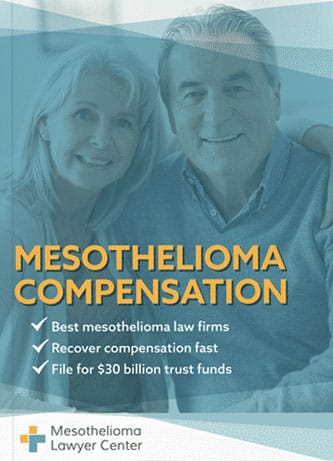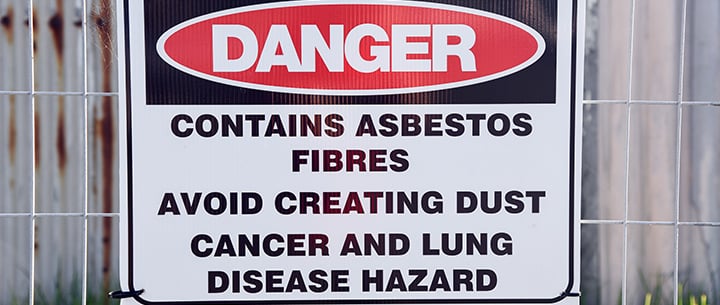La asbestosis es una enfermedad pulmonar causada por la exposición al asbesto, que provoca la formación de cicatrices en los pulmones. Los síntomas incluyen dificultad para respirar, dolor en el pecho y tos. La asbestosis no es reversible, pero los tratamientos ayudan a controlar los síntomas y a limitar el daño adicional al tejido pulmonar.
Si a usted o a un ser querido le han diagnosticado mesotelioma, asbestosis o cáncer relacionado con el asbesto, usted puede ser elegible para un beneficio sustancial compensación. Lo invitamos a completar nuestro formulario hoy para recibir un paquete de compensación financiera gratuito, lleno de información sobre abogados con experiencia en mesotelioma en su área, cómo recibir el pago en 90 días, cómo presentar un reclamo ante un fondo fiduciario de asbesto y mucho más.


Paquete de compensación financiera GRATUITO
- Información sobre despachos de abogados que recuperarán su INDEMNIZACIÓN MÁS ALTA
- Aprenda cómo cobrar en 90 días
- Solicite su parte de $30 mil millones en fondos fiduciarios

¿Qué es la asbestosis?
La asbestosis es una enfermedad respiratoria crónica que afecta los pulmones. Se produce por la inhalación de fibras de amianto. La exposición al amianto que provoca asbestosis suele ocurrir en el lugar de trabajo a lo largo de varios años.
Las fibras de asbesto en los pulmones provocan inflamación, lo que provoca cicatrización. Esta cicatrización es permanente y endurece el tejido pulmonar. Los síntomas del daño pulmonar relacionado con el asbesto a menudo no aparecen hasta décadas después de la exposición, incluso si el daño ya ha comenzado.
Acerca de la exposición al amianto y la asbestosis
Como ocurre con todas las enfermedades relacionadas con el amianto, las víctimas de asbestosis suelen estar expuestas a amianto en el trabajoEn muchos lugares de trabajo de la industria se utilizaban materiales que contenían asbesto (ACM) antes de que las regulaciones limitaran el uso del mineral.
El asbesto se usaba comúnmente en frenos, tuberías, pisos, tejas, cemento y como aislante. antes de que los peligros fueran más ampliamente conocidos.
Cuando se interrumpió la producción y el transporte de amianto, muchas víctimas ya habían estado expuestas a una cantidad tan grande de minerales tóxicos que su salud ya estaba en malas condiciones.
¿Quién está en riesgo de padecer asbestosis?
Cualquier persona expuesta al asbesto corre el riesgo de desarrollar asbestosis. El riesgo de asbestosis es más significativo con la exposición repetida y prolongada al asbesto en el lugar de trabajo. Estos son algunos ejemplos de ocupaciones con alto riesgo de exposición al asbesto antes de la década de 1980:
- Minería de amianto
- Automotor o reparación y mantenimiento de aeronaves
- Trabajos de caldera
- Construcción
- Demolición
- Fabricación industrial
- Trabajos de aislamiento
- Refinación de petróleo
- Generación de energía
- Construcción y reparación naval
- Marina de los EE. UU.
La exposición al asbesto es el factor de riesgo más crítico para la asbestosis, pero otros factores aumentan el riesgo de desarrollar la enfermedad:
- De fumar
- Mala salud
- Edad avanzada
- Factores genéticos y antecedentes familiares
¿En qué se diferencia la asbestosis del mesotelioma?
El mesotelioma es otra enfermedad causada por la exposición al asbesto. La diferencia principal es que la asbestosis es benigna y el mesotelioma es maligno. El mesotelioma es un crecimiento canceroso que comienza en la pleura, el tejido que rodea los pulmones.
Mesotelioma pleural Provoca algunos de los mismos síntomas que la asbestosis, pero es más mortal. Progresa rápidamente y casi siempre es mortal.
¿Qué causa la asbestosis?
La exposición al asbesto causa asbestosis. No todas las personas expuestas al asbesto la desarrollarán. El riesgo es mayor cuanto mayor sea la exposición y la exposición se repita durante un período prolongado.
Al inhalar asbesto, se corre el riesgo de que fibras microscópicas finas e inodoras se alojen en los pulmones. Estas fibras causan daños en el cuerpo, lo que provoca enfermedades como la asbestosis. La exposición al amianto es la causa de la asbestosis.
¿Cuáles son los síntomas de la asbestosis?
Nuevamente, algunas víctimas de asbestosis pueden no experimentar muchos síntomas y casi todas las víctimas tienen un largo período de latencia entre la exposición y los primeros síntomas. Los signos de advertencia más comunes de la asbestosis son:
- Opresión y dolor en el pecho
- Dificultad para respirar con falta de aire
- Un extraño sonido tipo crujido al inhalar
- Cambios en el apetito como pérdida del apetito.
- Dedos de las manos o de los pies en palillo de tambor
Los síntomas de las enfermedades causadas por el amianto, incluida la asbestosis, suelen tardar muchos años en aparecer. Pueden pasar décadas desde la exposición al amianto antes de que una persona presente síntomas suficientemente preocupantes como para buscar un diagnóstico.
Complicaciones de la asbestosis
La asbestosis también puede causar o contribuir al desarrollo de otras afecciones médicas. Entre las posibles complicaciones de la asbestosis se incluyen:
- Hipertensión pulmonar
- Insuficiencia respiratoria
- Mesotelioma pleural
- cáncer de pulmón
- Otros tipos de cáncer
- Daño cardíaco
¿Cómo se diagnostica la asbestosis?
Debido a que la asbestosis es progresiva y causa síntomas que afectan la calidad de vida, es importante obtener un diagnóstico lo antes posible.
Para diagnosticar la asbestosis, el médico suele comenzar con una historia clínica y un examen físico. Informe a su médico sobre cualquier exposición previa o sospecha de exposición al asbesto. Esta información es vital para un diagnóstico preciso.
El siguiente paso es someterse a estudios de diagnóstico por imágenes, como radiografías de tórax, para buscar líquido en los pulmones y descartar neumonía y otras enfermedades más comunes.
Una radiografía también puede detectar signos de asbestosis. La asbestosis en una radiografía tiene una apariencia de panal. Es más visible a medida que la enfermedad progresa.
Una tomografía computarizada muestra los huesos y los tejidos blandos de la cavidad torácica para ayudar a los médicos a buscar anomalías, como cicatrices o tumores. Una tomografía computarizada puede mostrar signos de asbestosis antes que una radiografía.
El siguiente paso suele ser una biopsia. En esta biopsia se extrae una pequeña cantidad de líquido o tejido para realizar pruebas diagnósticas. Hay dos maneras de realizar una biopsia para la prueba de asbestosis:
- Broncoscopia. Un broncoscopio es un pequeño tubo que se inserta en los pulmones a través de la boca o la nariz. Los médicos utilizan una pequeña cámara en el extremo del broncoscopio para obtener imágenes de los pulmones. También se puede utilizar para tomar una biopsia.
- Toracocentesis. Durante este procedimiento, el médico inserta una aguja en la cavidad torácica para extraer líquido. Solo requiere anestesia local.
Los patólogos analizan las muestras de biopsia para detectar células cancerosas. Esto es importante si tiene antecedentes de exposición al asbesto.
Tratamiento para la asbestosis
Aunque no existe cura, la asbestosis es tratable. Los tratamientos para la asbestosis ayudan a controlar los síntomas para mejorar la calidad de vida y prolongar la esperanza de vida.
Lo más importante que puede hacer un paciente con asbestosis es eliminar cualquier exposición continua al asbesto. La mayoría de las personas estuvieron expuestas hace años, pero si el asbesto persiste, eliminarlo ralentizará la progresión de la enfermedad.
Los tratamientos para la asbestosis incluyen:
- Rehabilitación pulmonarEste es un tipo de tratamiento que ayuda a optimizar la función respiratoria. Un neumólogo o terapeuta respiratorio utiliza diversas estrategias para ayudarle a respirar con mayor facilidad.
- Oxígeno suplementario. Los pulmones con cicatrices son rígidos y no se expanden tanto como los pulmones sanos. Esto dificulta el suministro de oxígeno adecuado. El oxígeno suplementario proporciona más oxígeno por respiración.
- Medicamentos en aerosol. Los medicamentos administrados en aerosol al sistema respiratorio diluyen el líquido en los pulmones, lo que facilita la respiración.
- Cirugía. La cirugía es un tratamiento poco común para la asbestosis. Muy pocos pacientes son elegibles para un trasplante de pulmón, pero para quienes sí lo son, puede ser una opción de tratamiento.
- Cambios en el estilo de vida. Los pacientes con asbestosis pueden beneficiarse de cambios en el estilo de vida, como dejar de fumar.
¿Cuál es el pronóstico para la asbestosis?
According to the American Lung Association (ALA), asbestosis can last a lifetime and can also be the cause of death. The severity of the disease varies by individual and depends on the amount of asbestos exposure and how soon treatment is started.
El mejor pronóstico para la asbestosis se da en pacientes con menor exposición al asbesto, un diagnóstico temprano y un tratamiento temprano.
¿Se puede curar la asbestosis?
No existe cura para la asbestosis, ya que el daño causado por las fibras de asbesto es permanente. Ningún tratamiento ni intervención puede revertir el daño. Los tratamientos pueden detenerlo y prolongar la vida.
En casos excepcionales, un paciente con asbestosis puede ser elegible para un trasplante de pulmón. Esta es la única manera de restaurar la función pulmonar, pero es un tratamiento poco común para esta enfermedad.
¿Cuál es la esperanza de vida de una persona con asbestosis?
Según un estudio sobre enfermedades relacionadas con el amianto, la edad media en la que las personas morían de asbestosis era de 79 años. Esto indica que es posible vivir muchos años con asbestosis.
Otro estudio demostró que la asbestosis Los pacientes con daños menores al promedio podrían vivir hasta 14 años después del diagnóstico. La esperanza de vida media de todos los pacientes del estudio fue de diez años.
El tratamiento que retarda la progresión de la asbestosis es el factor más importante para prolongar la esperanza de vida.
¿Qué sucede cuando alguien muere de asbestosis?
La asbestosis grave puede ser mortal, pero muchas personas viven con ella como una enfermedad crónica durante muchos años. La muerte podría deberse a una complicación u otra causa no relacionada.
Vivir con asbestosis
Además de los tratamientos médicos, pruebe estas estrategias de cuidado en el hogar para aliviar los síntomas y mejorar su calidad de vida.
Coma una dieta saludable
Llevar una dieta saludable mejora la salud general y permite tolerar mejor los tratamientos. y mejora la calidad de vida.
Una dieta saludable debe incluir muchas frutas y verduras y limitar el consumo de sal, según la Agencia para Sustancias Tóxicas y el Registro de Enfermedades (ATSDR).
Además, a menos que su médico le especifique lo contrario, debe beber al menos siete u ocho vasos de agua al día.
Duerma lo suficiente
Además de una dieta adecuada, las personas que viven con asbestosis siempre deben descansar lo suficiente. La ATSDR sugiere dormir al menos ocho horas por noche y tomar siestas ligeras. para reducir las posibilidades de cansarse demasiado.
Protege tus pulmones
Si tiene asbestosis, sus pulmones no funcionan con normalidad. Una de las medidas más importantes es dejar de fumar. Fumar empeora los síntomas e incluso puede acelerar su progresión. Si no fuma, proteja sus pulmones de otros contaminantes.
Permanezca en el interior si la contaminación o el smog son altos y evite acercarse demasiado a productos de limpieza que contengan aerosoles, vapores de gasolina y otros irritantes que puedan inflamar sus pulmones.
Realice un seguimiento de sus síntomas
Además, la ATSDR recomienda llevar un diario para registrar sus síntomas y las cosas que pueden haber desencadenado el dolor.
Preste mucha atención a las dificultades respiratorias y a la duración de cada episodio. Asegúrese de compartir esta información con su médico. Este podrá usarla para modificar el tratamiento o recomendar actividades que debe evitar.
Demandas por asbestosis
A principios de la década de 1980, el estado de Nueva Jersey experimentó la primera demanda colectiva por agravio después de que varias víctimas y familiares de víctimas fallecidas se presentaran para presentar reclamos por muerte injusta y lesiones personales.
Este fue el comienzo de lo que se convertiría en un estándar en los tribunales de todo el país a medida que más y más víctimas se presentaban.
Todos los demandantes en estos casos estuvieron expuestos al amianto., en particular el amianto crudo, que provoca asbestosis y otras enfermedades relacionadas con el amianto.
Los casos de asbestosis no se han limitado únicamente a los EE. UU. Por ejemplo, En 1984, un abogado australiano ayudó a más de 300 trabajadores a luchar por una compensación después de la exposición al asbesto. en el molino de Wittenoom.
Wittenoom es un parque nacional en Australia Occidental, pero lo que una vez fue un hermoso parque ahora es conocido como un lugar de sufrimiento luego de que miles de personas estuvieran expuestas al asbesto mientras trabajaban en la minería en la zona.
En otra demanda australiana, varias víctimas y familiares se presentaron después de ser... expuesto al amianto En el valle de Latrobe. La Comisión Estatal de Electricidad de Virginia (SECV) empleó trabajadores en sus centrales eléctricas.
Durante la construcción de la central, los empleados trabajaban a diario expuestos a grandes cantidades de amianto. Como resultado, a una buena parte de ellos se les diagnosticó posteriormente asbestosis.
Buscando una compensación por un diagnóstico de asbestosis
Si recibió un diagnóstico de asbestosis, hable con un abogado de asbestoPueden ayudarle a rastrear su exposición pasada al asbesto y emprender acciones legales para buscar una compensación.
El mesotelioma suele estar asociado con la recuperación de daños tras la exposición al asbesto, pero la asbestosis también da derecho a indemnización. Podría tener derecho a presentar una reclamación ante un fondo fiduciario para el asbesto o a demandar a las empresas que lo producen.
Si estuvo expuesto al asbesto en el ejército, podría calificar para Beneficios del VA. Un abogado con experiencia en mesotelioma Puede identificar todas sus opciones de compensación y ayudarle a dar los siguientes pasos.
Obtener ayuda legal
Si ha sufrido lesiones a causa de mesotelioma o cáncer relacionado con el asbesto, tenga en cuenta que existe una buena posibilidad de que califique para recibir una compensación considerable. No olvide completar nuestro formulario para obtener nuestro Paquete de compensación financiera gratuito, lleno de información sobre los abogados con experiencia en asbesto y mesotelioma en su área.

Pablo Danziger
Revisor y editorPaul Danziger creció en Houston, Texas, y se licenció en Derecho en la Facultad de Derecho de la Universidad Northwestern en Chicago. Durante más de 25 años, se ha dedicado a representar a víctimas de mesotelioma y a otras personas afectadas por la exposición al asbesto. Paul y su bufete han representado a miles de personas diagnosticadas con mesotelioma, asbestosis y cáncer de pulmón, obteniendo indemnizaciones significativas para los clientes lesionados. Cada cliente es fundamental para Paul y atenderá todas las llamadas de quienes deseen hablar con él. Paul y su bufete se encargan de casos de mesotelioma en todo Estados Unidos.
Conéctese con el abogado especializado en mesotelioma Paul Danziger
Referencias
- Centros para el Control y la Prevención de Enfermedades. Instituto Nacional para la Seguridad y Salud Ocupacional. (20 de enero de 2023). Asbesto.
Recuperado de: https://www.cdc.gov/niosh/topics/asbestos/ - Mayo Clinic. (11 de febrero de 2022). Asbestosis.
Recuperado de: https://www.mayoclinic.org/diseases-conditions/asbestosis/symptoms-causes/syc-20354637 - Asociación Americana del Pulmón (American Lung Association). (17 de noviembre de 2022). Tratamiento y manejo de la asbestosis.
Recuperado de: https://www.lung.org/lung-health-diseases/lung-disease-lookup/asbestosis/treating-and-managing - Kamp, DW (abril de 2009). Enfermedad pulmonar inducida por asbesto: Actualización. Res. 153(4), 143-52.
Recuperado de: https://www.ncbi.nlm.nih.gov/pmc/articles/PMC3544481/ - Moon Bang, K., Mazurek, JM, Wood, JM y Hendricks, SA (enero de 2014). Enfermedades atribuibles a la exposición al amianto: Años de vida potencial perdidos, Estados Unidos, 1999-2010. Am. J. Ind. Med. 57(1), 38-48.
Recuperado de: https://www.ncbi.nlm.nih.gov/pmc/articles/PMC4522907/ - Keskitalo, E., Salonen, J., Vahanikkila, H. y Kaarteenaho, R. (2021). La supervivencia de pacientes con asbestosis puede evaluarse mediante modelos de predicción de riesgo. Occup. Environ. Med. 78, 516-21.
Recuperado de: https://oem.bmj.com/content/78/7/516 - Bhandari, J., Thada, PK, Sedhai, YR (2022, 19 de septiembre). Asbestosis. Institutos Nacionales de Salud. Biblioteca Nacional de Medicina.
Recuperado de: https://www.ncbi.nlm.nih.gov/books/NBK555985/
